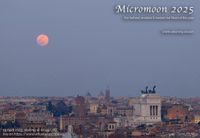This Sunday, April 13, 2025, skywatchers will be treated to a celestial spectacle known as the Pink Moon, marking the first full moon following the onset of autumn in the Southern Hemisphere. This unique astronomical event occurs when the Moon reaches its apogee—the point in its orbit that is farthest from Earth—resulting in a slight reduction in its apparent size, a phenomenon referred to as a Micromoon.
Despite its whimsical name, the Pink Moon will not actually appear pink. The term is derived from the Phlox subulata, commonly known as moss pink, a flower native to North America that typically blooms during this time of year. Thus, the name symbolizes a connection to nature and the changing seasons rather than indicating a color shift in the Moon itself.
The Pink Moon of 2025 will achieve its peak illumination at 21:22 (Brasília time) on April 13. This timing presents a perfect opportunity for enthusiasts and casual observers alike to enjoy the lunar display, particularly in areas with minimal light pollution where the Moon's brilliance can be fully appreciated.
In addition to its astronomical significance, the Pink Moon holds religious importance within the Christian calendar. The date of Easter is determined based on this lunar event, celebrated on the first Sunday following the appearance of the Pink Moon. Consequently, the 2025 Easter celebration will fall on April 20, just one week after the Pink Moon.
For those eager to catch a glimpse of the Pink Moon, here are some tips to enhance the viewing experience:
- Choose a location with low light pollution for an unobstructed view of the sky.
- Bring binoculars or a telescope to observe the intricate details of the lunar surface.
- Check the weather forecast to ensure clear skies for optimal visibility.
- Consider capturing the moment with photographs, adjusting exposure settings to highlight the Moon's luminosity.
The Pink Moon serves not only as a visual delight but also as a reminder of the interconnectedness of nature and human traditions. This phenomenon invites reflection on the passage of time and the relationship between natural cycles and cultural celebrations. Observing the Pink Moon can inspire a renewed appreciation for the universe and the events that unfold beyond our planet.
As the Pink Moon rises this Sunday, it will undoubtedly captivate those who take the time to look up and enjoy the wonders of the night sky. Whether it’s for the scientific intrigue or the cultural significance, the Pink Moon is set to shine bright, illuminating both the heavens and the hearts of those who witness it.







